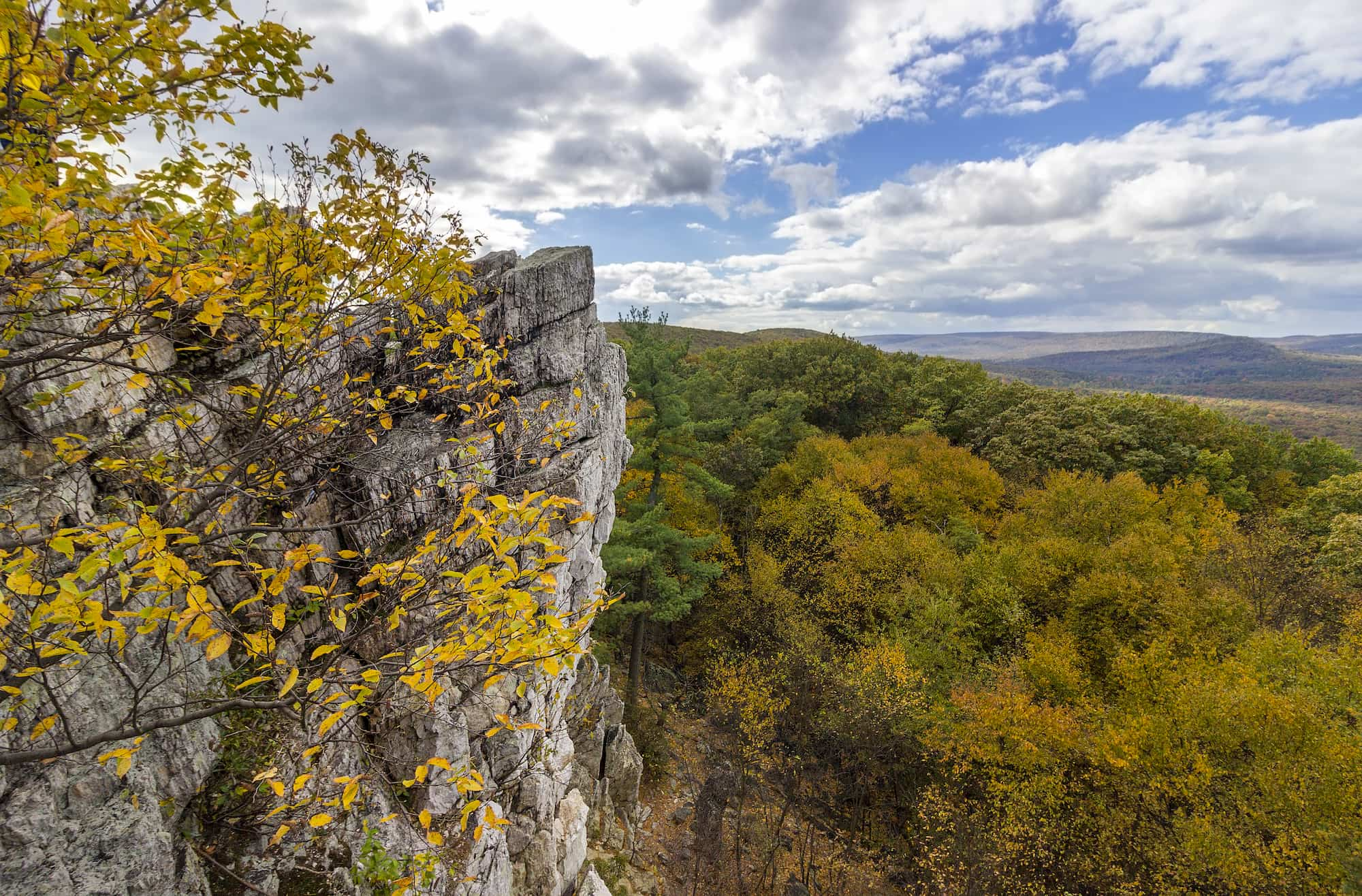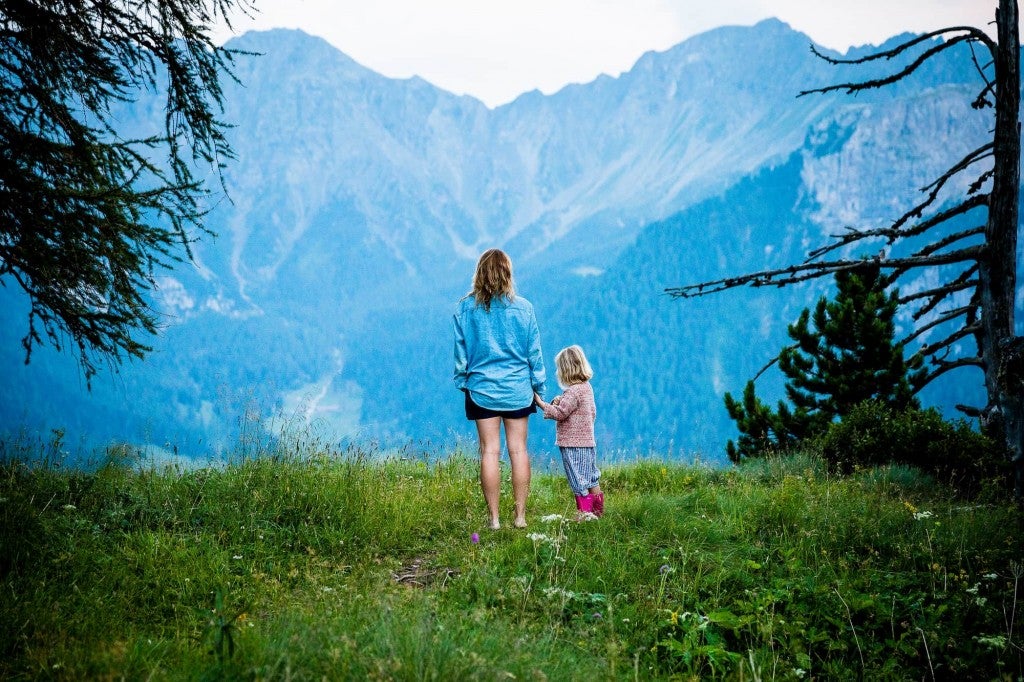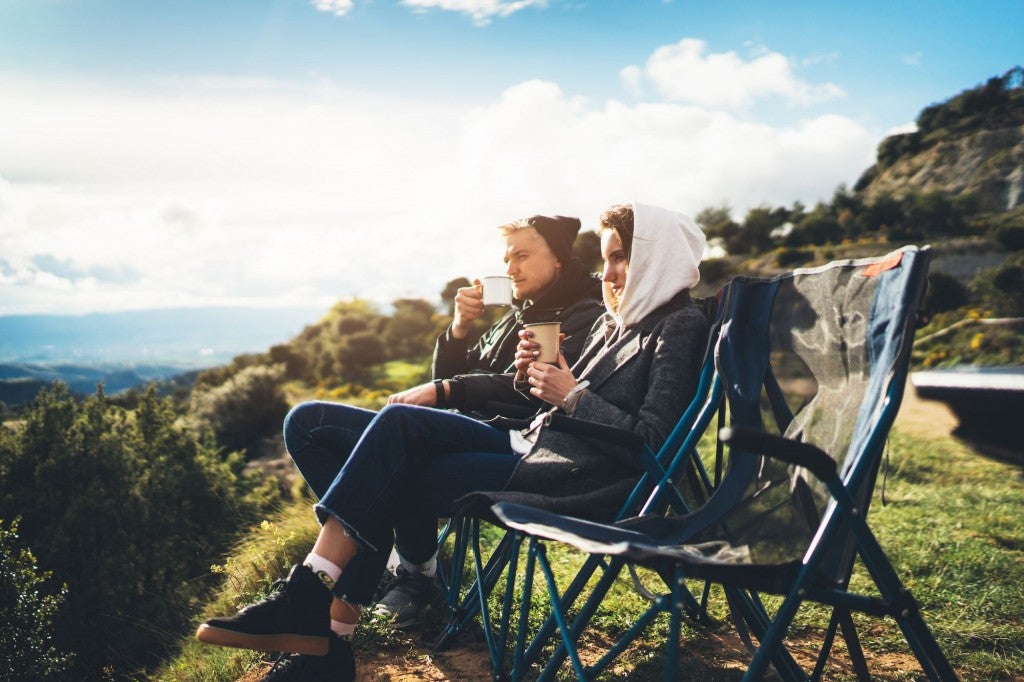As far as hiking the Appalachian Trail goes, Pennsylvania is a pretty flat state. But, what it lacks in elevation, it makes up for in rocks.
The Pennsylvania portion of the trail is strewn with boulders as big as soccer balls or basketballs. Some hikers even refer to the Appalachian Trail in PA as “Rocksylvannia.” The portion of the Appalachian Trail in PA is from mile marker 1,064 to mile 1,293. The north section of the Appalachian Trail PA is in the Poconos, a mountain region beginning at the 1,250-mile mark north of Allentown and extending all the way to the New York State line at mile 1,332. The highest point in PA is 2,040 feet.
No matter what you call it or what state you’re in, hiking the Appalachian Trail is free and no permits are required. But to find camping along the Appalachian Trail in Pennsylvania, it helps to plan in advance.
Three Ways to Find PA Appalachian Trail Camping
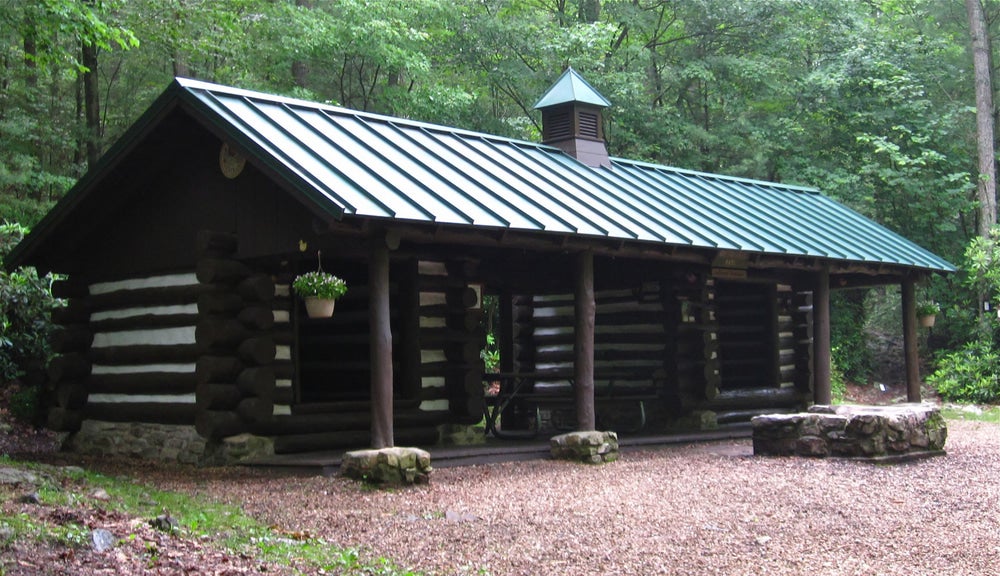
There are two main choices for Appalachian Trail PA camping; either staying in one of the many shelters along the way or pitching a tent in the backcountry.
Camping regulations vary greatly from state to state and even within each state. The lands that make up the trail are managed by more than 75 different agencies. There are state parks, federal wilderness areas, multi-use forests, game lands, wildlife refuges, watersheds, and even farmlands.
For instance, camping in Pennsylvania on State Game Lands requires all tents to be pitched within 200 feet of the trail but more than 500 feet from a spring, stream or public access point.
On all National Park Service lands that are outside national parks and forests, and state parks, forests, and game lands, camping is permitted at designated sites only. Most campsites, dispersed or in/near shelters, only allow for campers to stay one to two nights.
Parks and Forests with Appalachian Trail PA Camping
Delaware Water Gap National Recreation Area—Pennsylvania/New Jersey Border
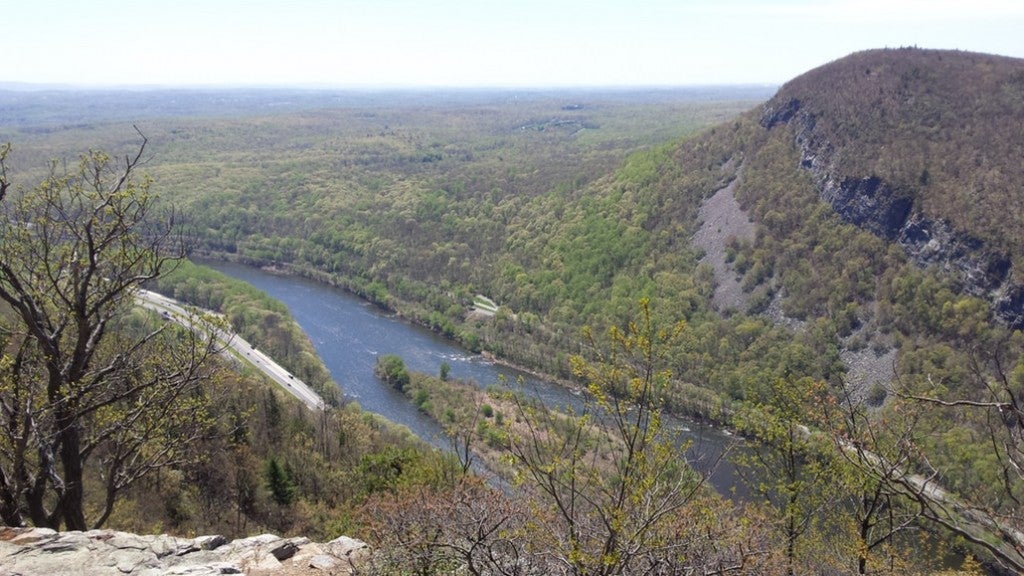
Image from The Dyrt camper John B.
Camping rules in the Delaware Water Gap Recreation Area for all visitors specify that there’s no camping within a half-mile of roadway, 100 feet of water or 200 feet from another party. Also, make sure you do not set up camp between a half-mile south of Blue Mountain Lake Road and 1 mile north of Crater Lake.
Thru-hikers looking for PA Appalachian Trail camping may only camp a minimum of 50 feet and a maximum of 100 feet from the trail. They must be a half-mile from any road, and group sizes must be less than 10 people. There is a camping fee payable at Mohican Outdoor Center on the Jersey side. No campfires of any kind are permitted in the area; only camp stoves.
Caledonia State Park—near Fayetteville, PA
Caledonia State Park is located on South Mountain at the northern end of the Blue Ridge Mountains. Camping is only allowed at designated sites in the park, and fires must be in fire rings. If you venture within 50 feet of the park office, you’ll be able to access the park’s wifi.
The greatest feature of this park is that there is access to the AT! – The Dyrt camper Amanda H.
Pine Grove Furnace State Park—near Harrisburg, PA
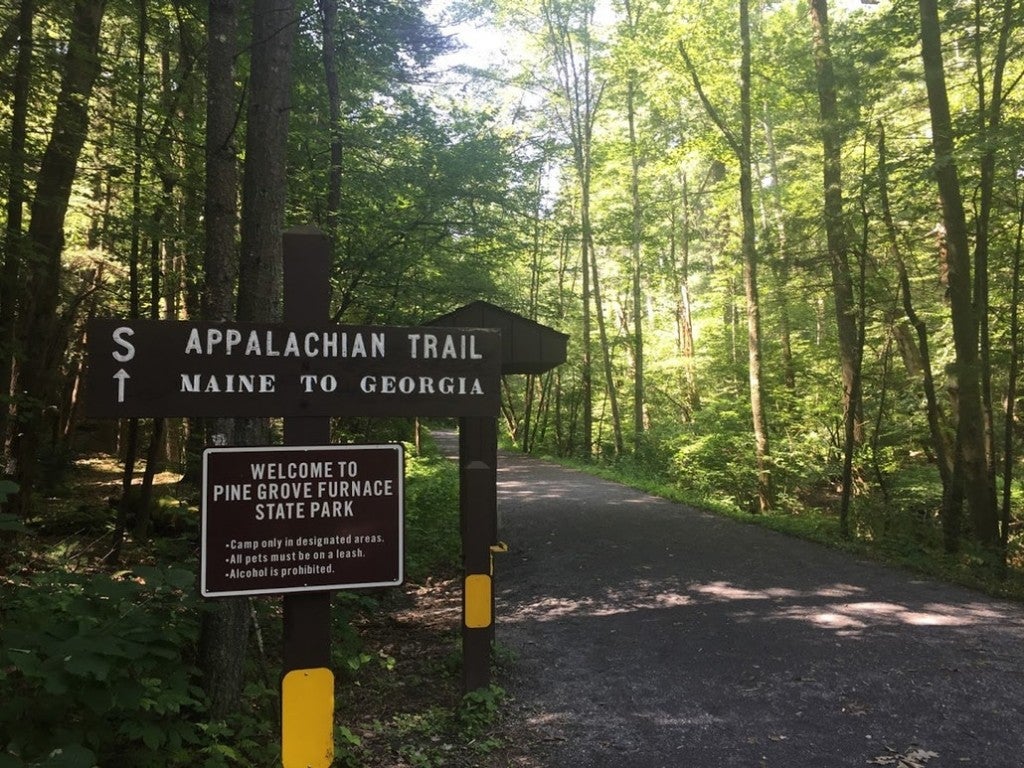
Image from The Dyrt camper Carly E.
Camping is allowed at Pine Grove Furnace State Park at the park campgrounds or within a half-mile from the trail.
There’s an Appalachian Trail Museum at Pine Grove Furnace State Park, as well as a camp store so you can replenish your supplies if needed. The Appalachian Trail Museum, near the mid-point on the entire trail, has exhibits and programs that celebrate some of the first trail builders and hikers. You can learn about Earl Shaffer, Grandma Gatewood, Gene Epsey,and Ed Garvey, among others. Both newcomers and veteran trail hikers are welcome. Visitors to the museum are often able to meet some of the current thru-hikers of the trail.
Shelter Camping on the Appalachian Trail PA
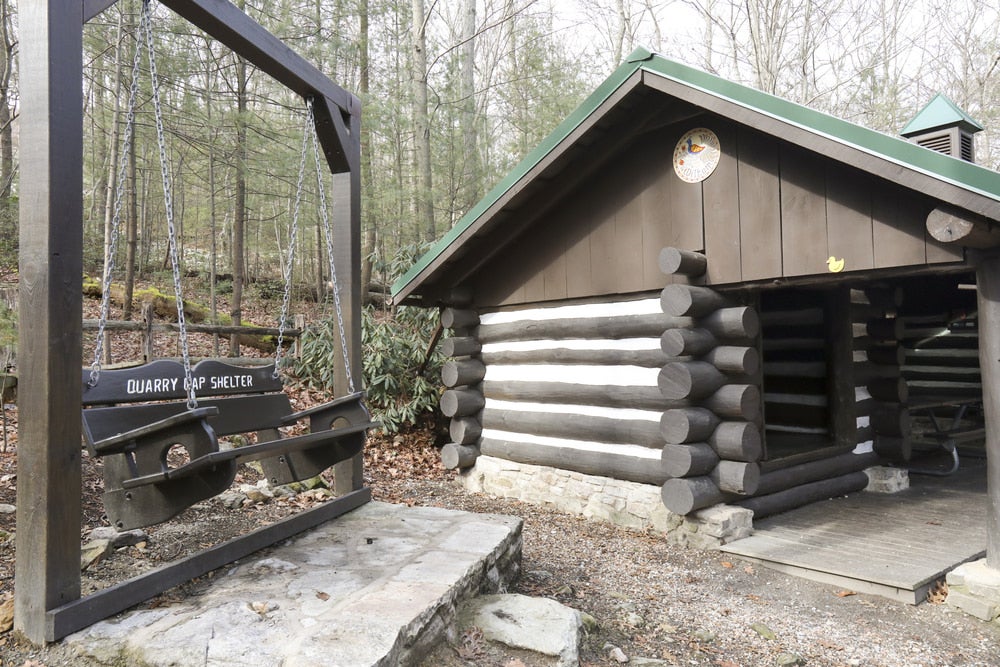
Like all Appalachian Trail camping shelters, you can’t pitch a tent inside a shelter and you must share it with hikers who arrive after you if there is reasonable room. Most shelters can accommodate around eight people, give or take a few. Many hikers enjoy staying in shelters because it gives them an opportunity to meet other people on the trail, share stories and give advice.
When staying at a shelter, practice common courtesy like making phone calls and smoking outside and away from the shelter, disposing of liquids 100 feet away from the shelter and collecting all litter. The Appalachian Trail and the lands it passes through are “carry in, carry out.” Also, try to avoid eating in a shelter, as crumbs attract rodents.
The PA portion of the Appalachian Trail has about 20 designated shelters. Following is a list with mile markers, though hikers should always consult a reliable map before heading out for a specific shelter. Most of them also come up in a Google map search (yay for technology) if wifi is available.
- Kirkridge Shelter, Bangor, PA
NOBO Mile Marker: 1286.6. SOBO Mile Marker: 902.5. Next Shelter North: 31.2 miles. Next Shelter South: 13.7 miles. Water and toilets are available. The capacity of the shelter is six people.
- Leroy A. Smith Shelter
NOBO Mile Marker: 1272.9. SOBO Mile Marker: 916.2 Next Shelter North: 13.7 miles. Next Shelter South: 16.7 miles. Both a water source and a privy are available. The capacity of the Leroy A. Smith shelter is eight people.
- George W. Outerbridge Shelter, Lehigh, PA
NOBO Mile Marker: 1256.2 SOBO Mile Marker: 932.9. Next Shelter North: 16.7 miles. Next Shelter South: 6.8 miles. This shelter has a water source but no privy. The capacity is six people.
- Bake Oven Shelter, Germansville, PA
NOBO Mile Marker: 1249.4. SOBO Mile Marker: 939.7. Next Shelter North: 6.8 miles. Next Shelter South: 10 miles. Be aware: Bake Oven doesn’t have a privy, and the water source is unreliable. Six people can stay here at a time.
- Allentown Shelter, Kempton, PA
NOBO Mile Marker: 1239.4. SOBO Mile Marker: 949.7 Next Shelter North: 10 miles. Next Shelter South: 7.4 miles. The Allentown Shelter has a water source, though its often unreliable. Eight people can stay in the shelter, and a privy is available.
- Eckville Shelter, Kempton, PA
NOBO Mile Marker: 1232. SOBO Mile Marker: 957.1. Next Shelter North: 7.4 miles. Next Shelter South: 9.1 miles. Eckville has both a water source and a privy.
- Windsor Furnace Shelter Lenhartsville, PA
NOBO Mile Marker: 1222.9. SOBO Mile Marker: 966.2. Next Shelter North: 9.1 miles. Next Shelter South: 14.7 miles. Windsor Furnace has a water source and a privy. The shelter can accommodate eight people.
- Eagles Nest Shelter, Auburn, PA
NOBO Mile Marker: 1208.2. SOBO Mile Marker: 980.9. Next Shelter North: 14.7 miles. Next Shelter South: 15.1 miles. Eagles Nest has water and a privy. The capacity of the shelter is eight people.
- Rausch Gap Shelter, Jonestown, PA
NOBO Mile Marker: 1175.6. SOBO Mile Marker: 1013.5. Next Shelter North: 13.4 miles. Next Shelter South: 18 miles. Water and privy are available, and there is space for up to six people.
- Peter’s Mountain Shelter, Halifax, PA
NOBO Mile Marker: 1157.6. SOBO Mile Marker: 1031.5. Next Shelter North: 18 miles. Next Shelter South: 6.7 miles. An unreliable water source and a privy are available at this PA Appalachian Trail camping shelter. There’s room for up to 16 hikers within the shelter, and is nearby Peter’s Mountain for an excellent vista.
- Clarks Ferry Shelter, Dauphin, PA
NOBO Mile Marker: 1150.9. SOBO Mile Marker:1038.2. Next Shelter North: 6.7 miles. Next Shelter South: 8.3 miles. With a capacity of eight people, the Clarks Ferry Shelter has a privy and a water source.
- Cove Mountain Shelter, Duncannon, PA
NOBO Mile Marker: 1142.6. SOBO Mile Marker: 1046.5. Next Shelter North: 8.3 miles. Next Shelter South: 7.3 miles. Eight people can sleep comfortably at the Cove Mountain Shelter. There is a privy and a water source.
- Darlington Shelter, Marysville, PA
NOBO Mile Marker: 1135.3. SOBO Mile Marker: 1053.8. Next Shelter North: 7.3 miles. Next Shelter South: 18.2 miles. The Darlington Shelter has an unreliable water source and a privy. The shelter accommodates five people. No dispersed camping is allowed between the Darlington Shelter and the Alec Kennedy because of nearby neighbors and a pretty narrow wilderness land corridor. There is, though, a backpacker’s campsite south of Boiling Springs. Be aware: this PA Appalachian Trail camping shelter comes complete with the noise of passing trains!
- Alec Kennedy Shelter, Boiling Springs, PA
NOBO Mile Marker: 1117.1. SOBO Mile Marker: 1072. Next Shelter North: 18.2 miles. Next Shelter South: 8.1 miles. The Alec Kennedy Shelter has an unreliable water source and a privy. Up to seven people can stay at a given time.
- James Fry Shelter, Cumberland, PA
NOBO Mile Marker: 1109. SOBO Mile Marker: 1080.1. Next Shelter North: 8.1 miles. Next Shelter South: 10.9 miles. There is water and a privy, and the capacity of the shelter is 9 people.
- Birch Run Shelters, Biglerville, PA
NOBO Mile Marker: 1091.9. SOBO Mile Marker: 1097.2. Next Shelter North: 6.2 miles. Next Shelter South: 7.4 miles. Birch Run has water and a privy and can sleep up to 10 people. Built in 1934 by workers from the Civilian Conservation Corps (CCC) in the Michaux State Forest, the Birch Run Shelters were originally a pair of smaller lean-tos rather than one bigger shelter. Many of the PA Appalachian Trail camping shelters on this section were built this way. In 1980, the two lean-tos were torn down and replaced by the one larger shelter that remains today.
- Quarry Gap Shelter, Fayetteville, PA
NOBO Mile Marker: 1084.5. SOBO Mile Marker: 1104.6. Next Shelter North: 7.4 miles. Next Shelter South: 5.6 miles. A privy and water source are nearby. The capacity is eight people. The Quarry Gap shelter is one of the nicest PA Appalachian Trail camping shelters in this portion—and in my opinion, one of the nicest anywhere. Innkeeper Jim Stauch manages the Quarry Gap shelter, which is actually two shelters joined by a covered porch area.
- Rocky Mountain Shelters, Fayetteville, PA
NOBO Mile Marker: 1078.9. SOBO Mile Marker: 1110.2. Next Shelter North: 5.6 miles. Next Shelter South: 6.6 miles. There is both a water source and a privy. The Rocky Mountain Shelters hold up to eight people.
- Tumbling Run Shelter, South Mountain, PA
NOBO Mile Marker: 1072.3. SOBO Mile Marker: 1116.8. Next Shelter North: 6.6 miles. Next Shelter South: 1.2 miles. There is water and a privy here. The shelter has an eight-person capacity.
- Deer Lick Shelters
NOBO Mile Marker: 1068.7. SOBO Mile Marker: 1120.4. Next Shelter North: 2.4 miles. Next Shelter South: 9.6 miles. The Deer Lick Shelters have a water source and a privy. They can accommodate up to 10 campers.
Backcountry Appalachian Trail PA Camping
There are about 100 designated backcountry PA Appalachian Trail camping sites along the Appalachian Trail. Backcountry camping is also permitted near the 250-plus shelters on the trail, though take note: Hikers are not allowed to pitch tents inside a shelter.
The designated campsites are very simple, consisting only of a flat place to pitch your tent with a natural water source nearby. Unlike shelter sites, they rarely have anything fancy like a privy.
Some areas permit dispersed camping, which means hikers can pick their site as long as they adhere to certain rules and restrictions. As stated above, these rules can change from area to area.
Hikers are encouraged to stay at designated sites, mainly because it lessens the impact on wildlife and vegetation along the trail. When choosing a place to spend the night, make sure that no broken branches or precarious looking trees are within falling distance of your tent.
Related Articles:
- Guide to The Pinhoti Trail
Related Campgrounds:
- Buttonwood Campground, Mifflintown, PA
- Lake in Wood Campground, Narvon, PA
- Vacationland Campground, Sandy Lake, PA
- Artillery Ridge Campground, Gettysburg, PA
- Hershey Camping Resort, Hershey, PA
- Knoebels Campground, Elysburg, PA
- Spring Gulch Campground, New Holland, PA
- Ohiopyle Campground, Ohiopyle, PA
- Red Oak Campground, Russell, PA
- Black Moshannon State Park, Centre County, PA
Popular Articles:
Articles on The Dyrt Magazine may contain links to affiliate websites. The Dyrt receives an affiliate commission for any purchases made by using such links at no additional cost to you the consumer.

